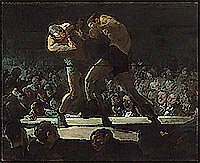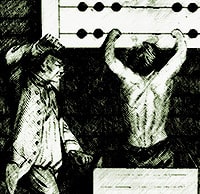Silly Nacho Legs on the You Tube channel Inthesegoingsdown asked a question about clenching the fist on a video concerning short baton work on the punching bag. It occurs here the similarity, the relationship, between making a fist for striking—essentially taking something better adapted to wielding a stick or stone, and using it as if it were a stone—provides a chance to illuminate both with the other. It is a theory of mine that the fist as a weapon was born when some ape man reached behind him while another of his savage fellows was attacking him, thinking to grab a stone and smash the attacker, only to clench nothing and in the heat of the moment striking with his own balled up hand—the fist.
The image of the fist is very martial and has only rarely come into use as an innovation. Less than a half dozen cultures around the world and down the stairs of Time we call history, have come up with the idea of using that which was designed to grab as a short club, a stabbing stone, a fist.
Аrуаn war bands
Egyptian stick fighters
Chinese monks
Okinawan MMA fighters
Polynesian islanders
These seem to be the only folk that ever came up with the idea in historic times to take what one uses to wield a hammer and decide to make it into one. Additionally, half of these probably got the idea via cultural diffusion from the one at the top of the list.
The fist is quite a symbol. Indeed, the single worst military commander in the age of Industrial annihilation, a certain Austrian artist and one-time eager German corporal, adopted the image of “the mailed fist” thrust into the heart of a massive enemy as an inspiration to perhaps the best army in human history, to commit operational suicide and die to a man in the middle of a frozen hell, out of supply and abandoned by their master, in a sea of overwhelming enemies.
Yes, the fist inspires.
But how does it work?
Let’s start with its basis, the use of a tool or weapon to generate a precise impact.
Hold tight, but not squeezing, with the middle finger.
Keep the thumb wrapped and the forefinger in contact and flex and relax these two digits for precision and control and to assist in stabilizing the power flexion of the smaller more powerful fingers. They line up with your eye and attach to the weak muscles of the thumb-side of the forearm.
Keep the ring finger and pinkie in loose contact while handling, then, at or just before the point of impact, squeeze to drive in and through, to penetrate, to shear, all depending on the forensics of the tool or weapon and its purpose. For instance, with a hammer you are squeezing just before impact with the nail to drive it in. You aren’t trying to drive that nail through the board like you would hitting a person, but drive it in. When I tried using a hammer to build my sister’s chicken coop last year, I was breaking boards with the hammer until I recalibrated my flexion of the flexor muscles and tendons of the outside of my hand which had been developed through stick fighting training, not craft hammering. My forearms are actually weak for carpentry and hammer use due to some injuries and lack of doing that work, yet caused damage to boards because the calibration was off.
Now, for punching, start with the four fingers bent in with each loose enough that they are not touching the palm.
The thumb is lightly latched under the forefinger. The thumb is what makes the pyx, or pug or box close. It is the latch used to firmly box the hand.
Throw the punch.
Before impact, just before, to impart whip to the punch, squeeze the hand, with the thumb sliding across the forefinger to latch it and the middle finger closed and the two small fingers curling into the palm, snuggly curled against the inward flexing heel of the hand. This gives the speed of the open hand to generate momentum and strikes with the density of the closed hand for penetration and maximum impartation of the force latent in the speed.
This action makes the fist progressively denser at contact and through contact as the punch penetrates.
If one hits before the hand is calibrated to close, the fist will still compress and prevent most injury to it as the contact forces it into denser configuration. This will impart less force to the target but should not damage the hand so long as the fist landed properly against a surface that was not harder than itself.
This is how I determined that Ravens running back Ray Rice had slapped and not punched his wife on the video described as a punch, as his hand was pimp-slap open after driving through her jaw, which would have been impossible with a punch, for even a loose punch would have been compressed into a tighter fist on and through impact.
Here we do not address the striking surface, which might be two knuckle, three-knuckle with either middle or ring finger used as the center knuckle, or hammer fist. All such have their optimal and poor applications, their dangers and their advantages. Yet all are served by flexion just before, on and through contact.
The pre-clenched fist is the slow fist, less jarring, less cutting and less damaging.
Curl the fist without clenching before punching.
Wrap the hand without squeezing before stroking with a weapon.











